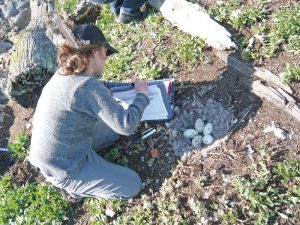Egg addling: controlling the non-native species on base
By Lookout on Jun 08, 2016 with Comments 0

Wildlife Technician Lorraine Crinkley documents the number of eggs addled for reporting to Environment Canada.
Lorraine Crinkley, Formation Environment ~
CFB Esquimalt has a large population of non-native, non-migratory Canada geese.
These geese were introduced locally approximately 50 years ago for hunting purposes, but changes in hunting regulations and a lack of natural predators have allowed their populations to increase exponentially.
Geese can live and breed for up to 20 years, and each year a nesting pair can produce an average clutch of five eggs.
Due to their population growth, a long-term population control program has been developed through the Capital Regional District’s Canada Goose Management Strategy.
This strategy aims to reduce impacts of non-migratory resident Canada geese to prevent conflict between geese and human activities.
Suggested mitigation techniques include habitat modification that makes an area less desirable to geese; water management, which addresses the location and characteristics of water features such as irrigation ponds that attract geese; hazing, which scares geese away from conflict areas; temporary relocation; and population control such as egg addling and strategic hunting.
CFB Esquimalt has participated in egg addling since 2008.
Egg addling involves removing eggs from the nest and shaking them, which disrupts the membrane and stops embryo development.
The eggs are marked and put back into the nest so the female goose will continue to sit on the eggs.
At the end of the season the eggs will simply not hatch. Eggs cannot be removed or destroyed as the female will just produce another clutch.
Both migratory and non-migratory Canada geese are protected under Environment Canada’s Migratory Bird Act, and all addling activities at CFB Esquimalt are conducted under Federal permit and require annual reporting.
I managed the 2016 addling season within Formation Safety and Environment (FSE). I am a Wildlife Technician and co-op student.
The 2016 addling season was a success with a total of 65 nests located throughout the Work Point, Dockyard and Naden properties.
Fieldwork is particularly enjoyable, as you never know what you are going to see or find.
The addling team observed several nests with golf balls and one with an orange road hockey ball that geese had found and rolled into their nests. It is common for geese to roll displaced eggs back in their nests to keep them safe.
This is a fixed action, so geese will attempt to roll any object in their nest that resembles an egg such as golf balls, doorknobs or eggs from other bird species.
Predation of goose eggs is quite common especially on the islands around CFB Esquimalt.
Predators include river otters, mink, crows, ravens and birds of prey.
When distinguishing a predated egg from a hatched egg there are a few things to look for: hatched eggs don’t contain any yolk or egg white and the two sides of the egg are found close together in close proximity to the nest.
If a gosling hatches in the nest the parent goose will remove the shell halves, often carrying one half of the egg inside the other.
Predated eggs contain remanence of yolk or egg white and will often be found a distance from the nest.
If the predator is another bird the egg will contain a hole where the predator has drained the contents.
During field days, the addling team got to explore areas of DND that are off limits to the general public, and we often found interesting treasures such as derelict buoys, animal bones, native plants such a camas, and local wildlife, including river otters, seals, herons and noisy oyster catchers.
Filed Under: Top Stories
About the Author:





